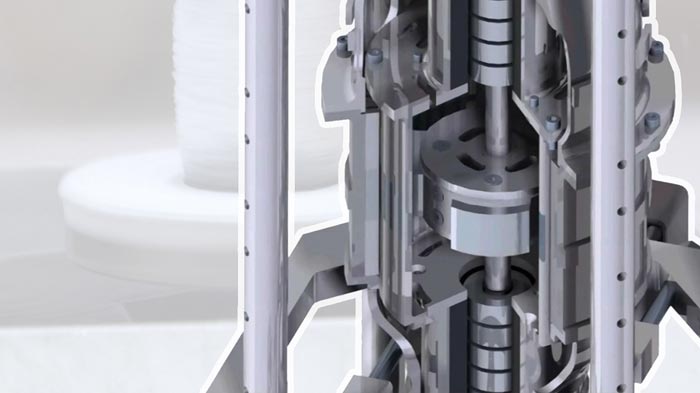Researchers Develop a Magnetic Levitating Gear

Credit: UC3M
This research is being carried out under the auspices of MAGDRIVE, a European research project coordinated by Professor José Luis Pérez Díaz, from the UC3M Instituto Pedro San Juan de Lastanosa, in which seven European entities participate.
It consists of the development of a magnetic gear reducer, that is, a mechanism that transforms speed from an input axle to another in an output axle (as in a bicycle chain mechanism or the gearbox of an automobile). But in this case, unlike a conventional gear reducer, this transmission is produced without contact between the pieces thanks to the magnetism.
One of its chief advantages is the absence of wear among the pieces, which makes lubrication unnecessary. As such, “the operating life of these devices can be much longer than the life of a conventional gear reducer with teeth, and can even work in cryogenic temperatures,” notes one of the researchers, Efrén Díez Jiménez, from the UC3M Department of Mechanical Engineering.
It can even continue to function after an event of overload. If the axle is blocked, “the parts simply slide amongst themselves, but nothing breaks.” In addition, less noise is produced, vibration is reduced, and it is capable of through-wall transmission.
A Gearbox that Levitates
In addition to the contactless transmission, the axles are likewise contactless. “It is the first time in history that the input axle as well as the output axle of a gear reducer are floating without any kind of contact, and it can keep a mechanism which contains nothing else spinning at 3,000 revolutions per minute at cryogenic temperatures” says the main researcher on the project, José Luis Pérez Díaz.
Although the main goal of the MAGDRIVE project is to build a prototype that can be used in extreme conditions in outer space, another one that can be used at room temperature has also been developed.
For outer space, the cryogenic prototype has been developed. This type keeps the axles floating and it can work at a temperature of -210°C and in a vacuum. The mechanism integrates levitating superconductor bearings that generate stable forces of repulsion into its structure. This allows it to turn and, moreover, it stabilizes it against oscillating motion or possible imbalances. It is the first mechanism in history that does not have this type of friction.
It has several applications in outer space, “from robot arms or antenna positioners, where high-precision movements are needed or when contamination from lubricants is undesired, to vehicles that, because of temperature or extreme conditions of absence of pressure, shorten the life of conventional mechanisms, as happens with the wheels of a Rover that has to go on Mars.”
The second prototype that has been developed can be used at room temperature. The magnetic reducer “substitutes the gear teeth with permanent magnets that repel and attract each other” so that “the transmission of couples and forces between the moving parts with contact is achieved,” explains Efrén Díez Jiménez.
Its applications can be transferred to any field where conventional mechanical reducers are used, such as self-propulsion, the railroad sector, the oil industry, or in mechanics and manufacturing in general, cite the researchers. Thanks to the absence of lubrication and oils, it can also be applied in the pharmaceutical, biomedical and food industries, where cleanliness requirements of are very strict.
Although the cryogenic prototype was the global objective of the project because it solved the problem posed by the European Space Agency (ESA),”no doubt the room temperature prototype is the one that can have the biggest impact and industrial application,” they conclude.
The final results of the MAGDRIVE project have been presented at different conferences, congresses and meetings organized by ESA, NASA and ASME, generating a great deal of interest among participants. The researchers have published some of the results in the “Journal of Engineering Tribology”, among others. At present they are analyzing implementation of these types of systems in different industrial areas. And, the latest news: their research has been accepted for upcoming publication in the review “Aerospace Science and Technology”.
http://portal.uc3m.es/portal/page/portal/actualidad_cientifica/noticias/magdrive_levitating
Full bibliographic information
J. Perez-Diaz, E. Diez-Jimenez, and E. Al., “Performance of magnetic-superconductor non-contact harmonic drive for cryogenic space applications,” Aerosp. Sci. Technol., 2014.
MAGDRIVE is a European project from the Space area of the European Union’s Seventh Framework Programme coordinated by Universidad Carlos III de Madrid, with the participation of the National Research Council of Genoa and the University of Cassino (both in Italy), the Foundation of the Faculty of Sciences at the University of Lisbon, in Portugal, and three companies: BPE from Germany, LIDAX from Spain and CAN Superconductors from the Czech Republic. This research project is FP7/2007-2013 under agreement No. 263014. In addition, the spin-off company MAG SOAR has been created from this project.
Further information:
Project webpage: www.magdrive.eu
Media Contact
All latest news from the category: Physics and Astronomy
This area deals with the fundamental laws and building blocks of nature and how they interact, the properties and the behavior of matter, and research into space and time and their structures.
innovations-report provides in-depth reports and articles on subjects such as astrophysics, laser technologies, nuclear, quantum, particle and solid-state physics, nanotechnologies, planetary research and findings (Mars, Venus) and developments related to the Hubble Telescope.
Newest articles

A ‘language’ for ML models to predict nanopore properties
A large number of 2D materials like graphene can have nanopores – small holes formed by missing atoms through which foreign substances can pass. The properties of these nanopores dictate many…

Clinically validated, wearable ultrasound patch
… for continuous blood pressure monitoring. A team of researchers at the University of California San Diego has developed a new and improved wearable ultrasound patch for continuous and noninvasive…

A new puzzle piece for string theory research
Dr. Ksenia Fedosova from the Cluster of Excellence Mathematics Münster, along with an international research team, has proven a conjecture in string theory that physicists had proposed regarding certain equations….



